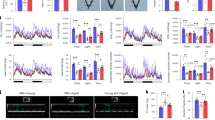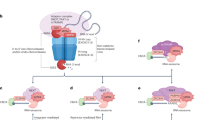Abstract
Autophagy is an evolutionarily conserved process by which cytoplasmic proteins and organelles are catabolized1,2. During starvation, the protein TOR (target of rapamycin), a nutrient-responsive kinase, is inhibited, and this induces autophagy. In autophagy, double-membrane autophagosomes envelop and sequester intracellular components and then fuse with lysosomes to form autolysosomes, which degrade their contents to regenerate nutrients. Current models of autophagy terminate with the degradation of the autophagosome cargo in autolysosomes3,4,5, but the regulation of autophagy in response to nutrients and the subsequent fate of the autolysosome are poorly understood. Here we show that mTOR signalling in rat kidney cells is inhibited during initiation of autophagy, but reactivated by prolonged starvation. Reactivation of mTOR is autophagy-dependent and requires the degradation of autolysosomal products. Increased mTOR activity attenuates autophagy and generates proto-lysosomal tubules and vesicles that extrude from autolysosomes and ultimately mature into functional lysosomes, thereby restoring the full complement of lysosomes in the cell—a process we identify in multiple animal species. Thus, an evolutionarily conserved cycle in autophagy governs nutrient sensing and lysosome homeostasis during starvation.
This is a preview of subscription content, access via your institution
Access options
Subscribe to this journal
Receive 51 print issues and online access
$199.00 per year
only $3.90 per issue
Buy this article
- Purchase on Springer Link
- Instant access to full article PDF
Prices may be subject to local taxes which are calculated during checkout




Similar content being viewed by others
References
Mizushima, N. Autophagy: process and function. Genes Dev. 21, 2861–2873 (2007)
Xie, Z. & Klionsky, D. J. Autophagosome formation: core machinery and adaptations. Nature Cell Biol. 9, 1102–1109 (2007)
Jager, S. et al. Role for Rab7 in maturation of late autophagic vacuoles. J. Cell Sci. 117, 4837–4848 (2004)
Jahreiss, L., Menzies, F. M. & Rubinsztein, D. C. The itinerary of autophagosomes: from peripheral formation to kiss-and-run fusion with lysosomes. Traffic 9, 574–587 (2008)
Kimura, S., Noda, T. & Yoshimori, T. Dissection of the autophagosome maturation process by a novel reporter protein, tandem fluorescent-tagged LC3. Autophagy 3, 452–460 (2007)
Scott, R. C., Schuldiner, O. & Neufeld, T. P. Role and regulation of starvation-induced autophagy in the Drosophila fat body. Dev. Cell 7, 167–178 (2004)
Wullschleger, S., Loewith, R. & Hall, M. N. TOR signaling in growth and metabolism. Cell 124, 471–484 (2006)
Massey, A. C., Follenzi, A., Kiffin, R., Zhang, C. & Cuervo, A. M. Early cellular changes after blockage of chaperone-mediated autophagy. Autophagy 4, 442–456 (2008)
Mizushima, N. & Kuma, A. Autophagosomes in GFP-LC3 transgenic mice. Methods Mol. Biol. 445, 119–124 (2008)
Dennis, P. B. et al. Mammalian TOR: a homeostatic ATP sensor. Science 294, 1102–1105 (2001)
Ravikumar, B. et al. Inhibition of mTOR induces autophagy and reduces toxicity of polyglutamine expansions in fly and mouse models of Huntington disease. Nature Genet. 36, 585–595 (2004)
Sancak, Y. et al. The Rag GTPases bind raptor and mediate amino acid signaling to mTORC1. Science 320, 1496–1501 (2008)
Yu, L., Lenardo, M. J. & Baehrecke, E. H. Autophagy and caspases: a new cell death program. Cell Cycle 3, 1124–1126 (2004)
Yu, L., Strandberg, L. & Lenardo, M. J. The selectivity of autophagy and its role in cell death and survival. Autophagy 4, 567–573 (2008)
Yu, L. et al. Regulation of an ATG7-beclin 1 program of autophagic cell death by caspase-8. Science 304, 1500–1502 (2004)
Slot, J. W. & Geuze, H. J. Cryosectioning and immunolabeling. Nature Protocols 2, 2480–2491 (2007)
Bidère, N. et al. Casein kinase 1α governs antigen-receptor-induced NF-κB activation and human lymphoma cell survival. Nature 458, 92–96 (2009)
Acknowledgements
We thank the National Institute of Allergy and Infectious Diseases (NIAID) imaging core facility and Olympus China for technical support; O. Schwartz, J. Kabat, L. Koo, M. Czapiga (Bio-imaging facility (BIF), NIAID, NIH) and Q. Dong (Olympus China) for assistance with confocal microscopy and imaging processing; K. Nagashima and M. J. de la Cruz (NCI) for TEM analyses: J. Lippincott-Schwartz, H Bernstein, and J. Bonifacino for helpful discussions; D. Yamamoto, G. Davis and H. Kramer for constructs and fly strains; and M. v. Peski and R. Scriwanek for assistance with the preparation of the EM figures. This research was supported by the Division of Intramural Research of the NIAID, NIH, Department of Health and Human Services and NIH Grant GM079431 to E.B., 973 program 2010CB833704, NSF grant 20091300700, and Tsinghua University grant 20091081391 to Y.L. J.K. is the recipient of VICI grant 918.56.611 of the Netherlands Organisation for Scientific Research (NWO).
Author information
Authors and Affiliations
Contributions
L.Y. first observed lysosome reformation at the end of autophagy, autophagy dependent mTOR reactivation and performed the original characterization of the phenomenon. G.A.M. and D.W.H. made critical DNA constructs and designed the live imaging experiments. L.Z. performed the density gradient analyses. C.K.M. performed Drosophila experiments. V.O. performed immuno-TEM analyses. M.J.L. and L.Y. wrote the manuscript and J.P., Y.R., N.M., Y.Z., Z.L. and F.W. helped in the manuscript revision experiments. Most of the experiments were performed by L.Y. and were conceived by L.Y., E.H.B. and M.J.L. J.K. conceived and executed certain E.M. experiments. All authors wrote, discussed and revised the manuscript.
Corresponding author
Ethics declarations
Competing interests
The authors declare no competing financial interests.
Supplementary information
Supplementary Information
This file contains Supplementary Figures S1-S19 with legends, full legends for Supplementary Movies 1-3 and Supplementary Methods. (PDF 4940 kb)
Supplementary Movie 1
This movie shows that multiple lysosomes fuse with GFP-LC3-labeled autophagic vesicle (see movie legend S1 in Supplementary Information file). (AVI 5489 kb)
Supplementary Movie 2
This movie shows tubules extending from autolysosomal membranes (arrow) and small Lamp1-positive vesicles pinching off from the tips of tubules (see movie legend S2 in Supplementary Information file). (MOV 2730 kb)
Supplementary Movie 3
This movie shows tubules breaking away from autolysosomes and condensing into Lamp1-positive vesicles (see movie legend S3 in Supplementary Information file). (AVI 3733 kb)
The Supplementary Information file and this table of contents were updated and replaced on 07 July 2010.
Rights and permissions
About this article
Cite this article
Yu, L., McPhee, C., Zheng, L. et al. Termination of autophagy and reformation of lysosomes regulated by mTOR. Nature 465, 942–946 (2010). https://doi.org/10.1038/nature09076
Received:
Accepted:
Published:
Issue Date:
DOI: https://doi.org/10.1038/nature09076
This article is cited by
-
Olanzapine, risperidone and ziprasidone differently affect lysosomal function and autophagy, reflecting their different metabolic risk in patients
Translational Psychiatry (2024)
-
mTORC1 in energy expenditure: consequences for obesity
Nature Reviews Endocrinology (2024)
-
Regulation of autophagy by perilysosomal calcium: a new player in β-cell lipotoxicity
Experimental & Molecular Medicine (2024)
-
PRKAA2, MTOR, and TFEB in the regulation of lysosomal damage response and autophagy
Journal of Molecular Medicine (2024)
-
Long-lasting postoperative analgesia with local anesthetic-loaded hydrogels prevent tumor recurrence via enhancing CD8+T cell infiltration
Journal of Nanobiotechnology (2023)
Comments
By submitting a comment you agree to abide by our Terms and Community Guidelines. If you find something abusive or that does not comply with our terms or guidelines please flag it as inappropriate.



